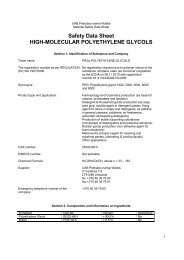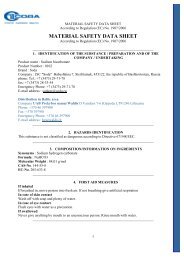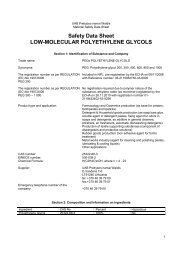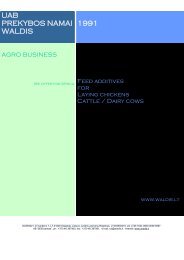Create successful ePaper yourself
Turn your PDF publications into a flip-book with our unique Google optimized e-Paper software.
UŽDAROJI AKCINĖ BENDROVĖ<br />
PREKYBOS NAMAI “WALDIS”<br />
D.Vandens 7-6, 91246 Klaipėda<br />
C5H14ClNO<br />
(2-hydroxyethyl) trimethylammonium <strong>chloride</strong><br />
<strong>choline</strong> <strong>chloride</strong><br />
Specifications<br />
Choline Chloride min % w/w 97<br />
metod of analysis<br />
18/51256/02-01/01<br />
H2O % w/w<br />
Description<br />
0,7 18/51256/02-01/01<br />
(2-hydroxyethyl) trimethylammonium <strong>chloride</strong> or <strong>choline</strong> <strong>chloride</strong> is an essential nutrient. and flnds<br />
its main application as a feed additive.<br />
Сholine <strong>chloride</strong>:<br />
an aqueous solution of <strong>choline</strong> <strong>chloride</strong> is a clear, colorless and nearly odorless liquid. The stendard<br />
grade material has a concentration of 97%, which is equivalent to 651 mg/g <strong>choline</strong>.<br />
Сhemical properties<br />
Molecular weight 139.6 g/mol<br />
CAS Nr 67-48-1<br />
EINECS Nr 200-655-4<br />
Quality Management & Gontrol<br />
In the interest of its customers, company follows a number of strict rules to guarantee the qualiiy of<br />
<strong>choline</strong> <strong>chloride</strong> as a high valuabte feed additive.<br />
Methods of Analysis<br />
Research from recent years clearly shows that the <strong>choline</strong> <strong>chloride</strong> content from some competitive<br />
sources is significantly lower than the content which is mentioned on the certificates of analysis, due<br />
to intentional adulteratisn of the product by adding other <strong>chloride</strong>s, e.g. household salt. When<br />
analyzing <strong>choline</strong> <strong>chloride</strong> with ihe standard Volhardt meihod (= the <strong>chloride</strong> method), this cornrnon<br />
salt will be calculated as <strong>choline</strong> <strong>chloride</strong>. Therefore, if the product quality is suspected, we<br />
recommend to use a more selective method of analysis, for example the Reinecke salt gravimetric<br />
method or ion chromatography<br />
Packaging:<br />
Multilayer bags with moisture barrier (25 kg net)<br />
External layer: PES with aluminium foil barrier<br />
Internal layer: coex linear low MDPE<br />
Shelf-life 12 months (1 year) when stored in closed drums or containers at room lemperature.<br />
Choline <strong>chloride</strong> is commonly classified as a vitamin. It belongs to the family of water soluble Bvitamins.<br />
It was formerly known as vitamin B4. Like other vitamins, it plays a significant role in<br />
nutrition, but its daily requirement seems to be hundreds of times greater than that of other vitamins.<br />
Choline <strong>chloride</strong> has three essential metabolic functions :<br />
� As constituent of phospholipids, improving fat transport and cell construction<br />
� As a precursor in the synthesis of acetyl<strong>choline</strong>, interacting in muscle control<br />
(neurotransmitter)<br />
� As a source of labile methyl groups, essential for numerous biological processes.<br />
1
Choline <strong>chloride</strong> occurs in almost all feed ingredients (see for example publications by the NRC);<br />
however not all naturally occurring <strong>choline</strong> is bio-available. Many animals have a <strong>choline</strong><br />
requirement that is not fully covered by the natural <strong>choline</strong> content of the feed. Therefore extra<br />
<strong>choline</strong> is often supplemented, and <strong>choline</strong> <strong>chloride</strong> salt is the common form in which <strong>choline</strong> is<br />
added to the feed. Addition levels vary by species, but are also dependent on age, feed composition,<br />
environmental stress, and breed. The required addition level is the difference between the<br />
requirements on the one hand and the levels of natural available <strong>choline</strong> on the other. It is further<br />
augmented with a safety margin, to cover up for variations of <strong>choline</strong> levels in natural feed<br />
ingredients.<br />
Dosing<br />
The following supplementation levels reflect average recommendation values for <strong>choline</strong> <strong>chloride</strong><br />
addition of to practical diets:<br />
Species Choline <strong>chloride</strong> supplement<br />
in mg/kg feed (90 % dry<br />
matter)<br />
Broilers Starting (0-8 weeks) 600-850<br />
Broilers Growing (8-18 w.) 350-700<br />
Layers 300-600<br />
Layers Breeding 350-700<br />
Turkeys Starting (0-8 weeks) 950-1200<br />
Turkeys Fattening (8-end) 600-850<br />
Turkeys Breeding 600-850<br />
Ducks Market/Breeding 1100<br />
Pigs Starting (10-25 kg) 350-700<br />
Pigs Growing (25-60 kg) 250-500<br />
Pigs Finishing(60kg-end) 200-350<br />
Pigs Gestating/Lactating 200-600<br />
Fish depends on species 350-950<br />
Shrimp 500-700<br />
Calves 250-350<br />
Dogs 1200-1400<br />
Cats 1200-1650<br />
These recommendations can serve as a general guideline only, since diet composition and vitamin<br />
availability from regular feed ingredients can vary greatly.<br />
UAB PN “<strong>Waldis</strong>”, įmonės kodas 140393021, D.Vandens 7-6, LT-91246 Klaipėda, tel. +370 46 39 79 00,<br />
faksas +370 46 39 79 01, el.paštas rol@waldis.lt for@waldis.lt<br />
2






